The Intel SSD 510 Review
by Anand Lal Shimpi on March 2, 2011 1:23 AM EST- Posted in
- IT Computing
- Storage
- SSDs
- Intel
- Intel SSD 510
Overall System Performance using PCMark Vantage
Next up is PCMark Vantage, another system-wide performance suite. For those of you who aren’t familiar with PCMark Vantage, it ends up being the most real-world-like hard drive test I can come up with. It runs things like application launches, file searches, web browsing, contacts searching, video playback, photo editing and other completely mundane but real-world tasks. I’ve described the benchmark in great detail before but if you’d like to read up on what it does in particular, take a look at Futuremark’s whitepaper on the benchmark; it’s not perfect, but it’s good enough to be a member of a comprehensive storage benchmark suite. Any performance impacts here would most likely be reflected in the real world.
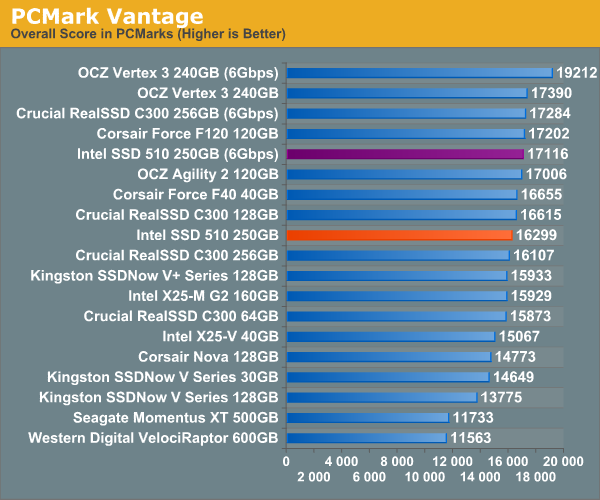
PCMark Vantage doesn't look too good paired with the 510. On a 6Gbps controller the Intel SSD 510 performs in line with the 3Gbps Vertex 3, however the 6Gbps Vertex 3 is untouchable. And over a 3Gbps interface the 510 is no better than a C300.
The pure HDD tests (below) are, at best, SF-1200 level. The SF-2200 is untouchable here. Based on what we've seen thus far I'm guessing this has a lot to do with the random read performance of the 510 once more.
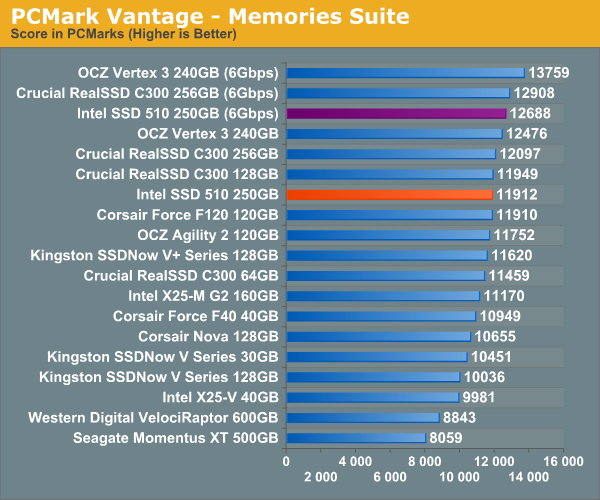
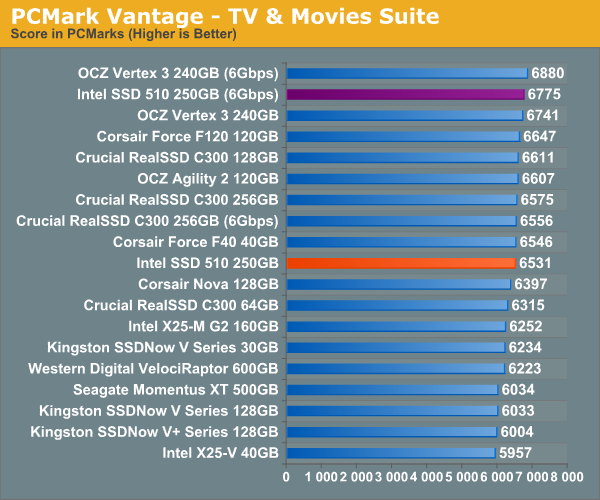
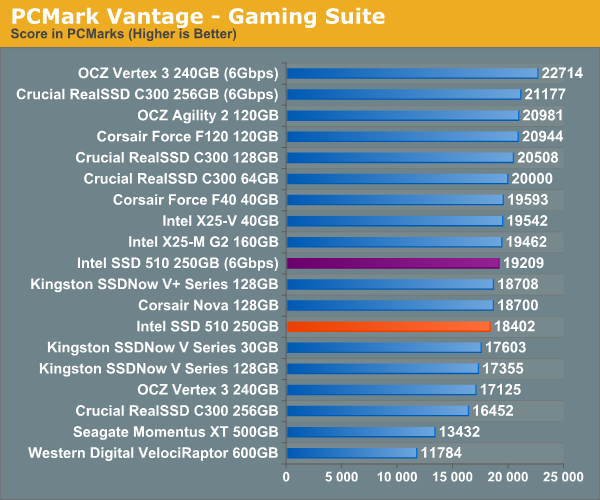

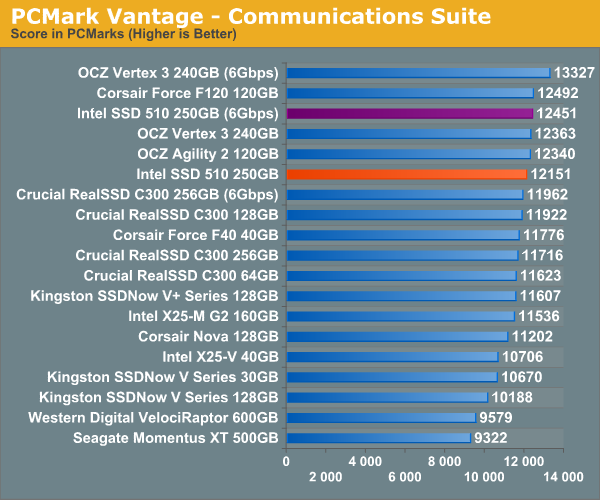
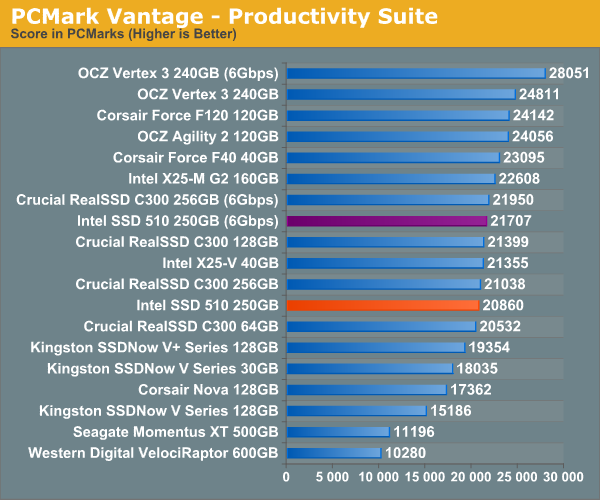
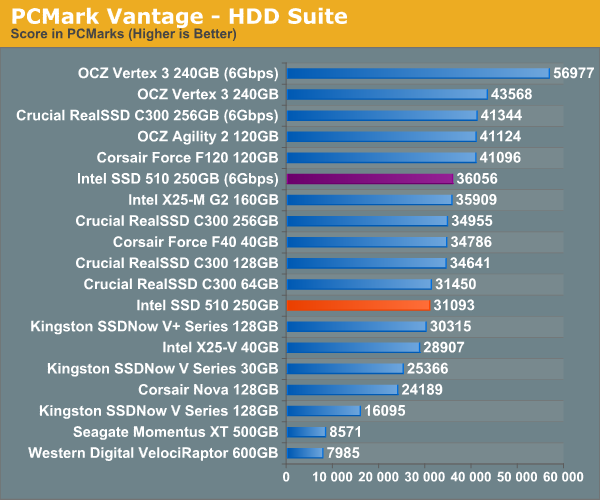










128 Comments
View All Comments
TSnor - Wednesday, March 2, 2011 - link
Article says "Write speed with fully incompressible data is easily a victory for the SF-2200 based OCZ Vertex 3. "I think you meant "Write speed with compressible data is easily a victory for the SF-2200 based OCZ Vertex 3. "
Excellent article, I was interested in the 3rd gen intel SSD, but not at these specs. Wish you gave the read latency time (it can be inferred to some degree from the elapsed time charts which are good). Also, given the size of internal cache these devices use perhaps running for more than 3 mins would be a good idea. The average performance is still changing at 3 mins.
AstroGuardian - Wednesday, March 2, 2011 - link
"I mentioned earlier that the 510 would go through Intel’s extensive validation testing, just like any other Intel product."Yea right! Just like the H67 and P67. Yea, that made me so happy.
Anand Lal Shimpi - Wednesday, March 2, 2011 - link
That's 100% a valid point and it does show that even with extensive validation errors can still get through.You'll remember that the X25-M was the first to have major firmware issues before any of its present day competitors were even created.
Only time will tell how well Intel has learned from those experiences and how seriously it's taking the validation of the 510. Initial compatibility testing looks good but we've got a long road ahead of us.
Take care,
Anand
Ryomitomo - Thursday, March 3, 2011 - link
At least Intel's labs identified the problems themselves, disclosed the problem themselves, will recall and exchange to fix the problem.These things makes me feel very confident to buy future Intel products.
Nihility - Thursday, March 3, 2011 - link
A good point. Unlike certain NVIDIA mobile chipsets.Chloiber - Wednesday, March 2, 2011 - link
...I think Anand is right. Many of you are complaining, but as he said on the final page: it is not clear, where the actual limits are for random speeds. Of course, it's always better to have more. The thing is, that your PC at home can't benefit from 60'000 IOPS. It just can't. You can run it through benchmarks which show high numbers, but as soon as you feed the drive and the CPU with real data, the drive is NOT the limiting factor anymore.I'm not saying that it's a good thing the Intel 510 has such low random speeds, compared to other, even older drives. But in the end, the question is whether or not you can actually benefit from 200MB/s random reads and random writes with QDs above 4.
Anand said himself, and I assure you that he is correct - you can trace it yourself if you want - that with standard workload on home desktop PCs, Queue Depth rarely exceeds 1 or 2, especially not with an SSD in your system. Not even during boot!
And now THINK AGAIN. What are the random 4k read speeds for low QD of EVERY SSD today? It's actually limited by the NAND being used and it's between 20MB/s and 30MB/s for EVERY SSD.
Again, I'm not saying that high IOPS aren't important. I'm just saying, they aren't as important as you think. Not anymore, not in the very high regions we are today and especially not with very high QDs.
The 510 seems to have very good performance in real world benchmarks - it seems that most of you rate synthetic benchmarks higher than real world benchmarks. This, I don't quite understand.
semo - Wednesday, March 2, 2011 - link
The fact is, you will not be using a very competitively priced 250GB SSD for net browsing. When I get my SSD, I'll be using it to store my test VMs where I do a lot of software installations and snapshot jumping.The 510 is not a mainstream product where the QD rarely goes above 2. Not at that price at least. I've installed an SSD for a few average users but they were all 60GB drives. I could never justify the price of a 250GB SSD to them but a pro user might (i.e. someone who might make use of a high IOPS drive).
semo - Wednesday, March 2, 2011 - link
Meant to say "uncompetitively". Too expensive for the average computer user.tno - Thursday, March 3, 2011 - link
Spot on, and so a mainstream drive this is not. As workstation drive, however, this seems pretty solid.Nentor - Wednesday, March 2, 2011 - link
If it (the 510) was very cheap everything you say makes sense, but since it is not they'd better make it as fast as possible.